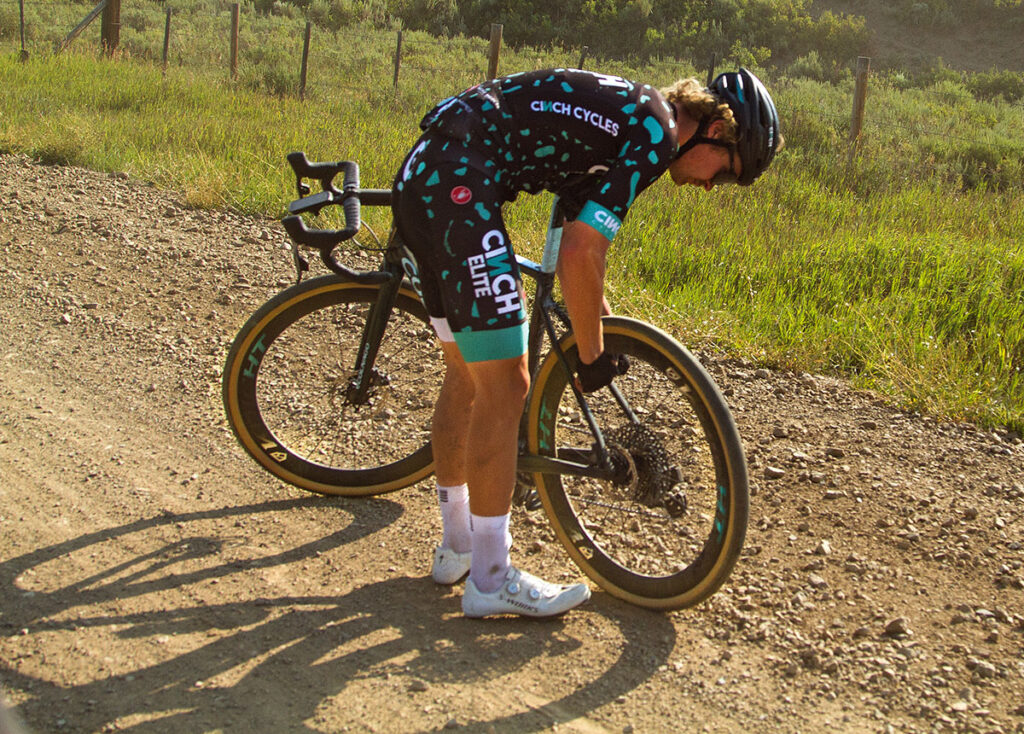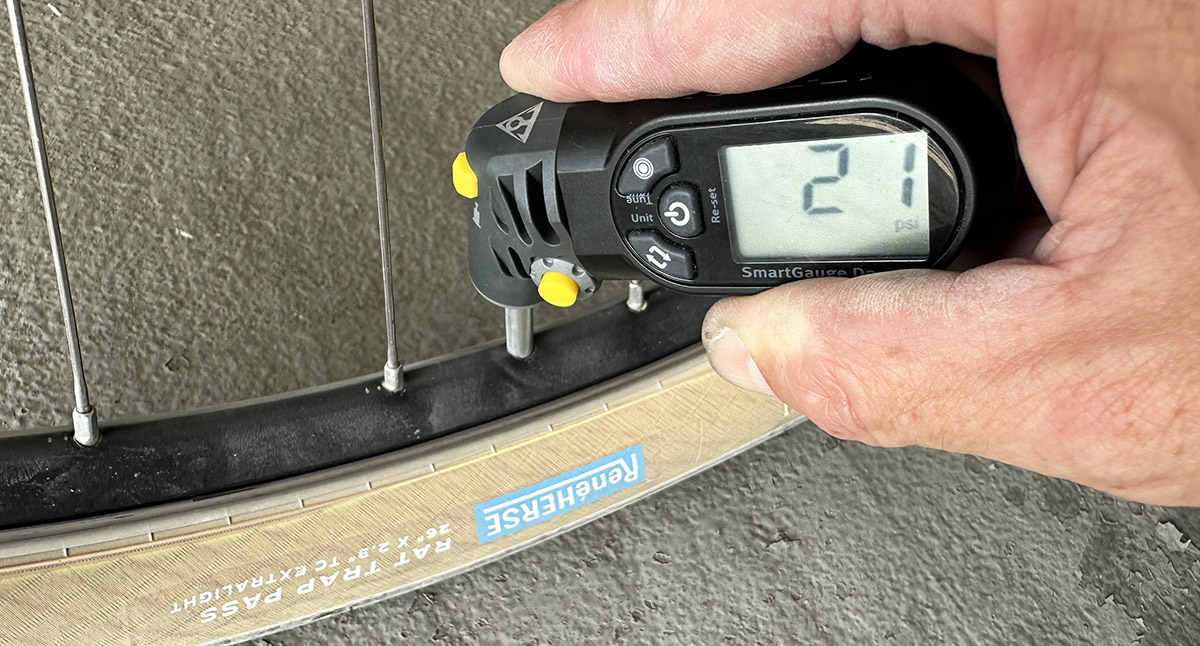Tire Pressure for Unbound
Yesterday’s post about my Unbound XL bike mentioned tire pressure: 21 psi (1.5 bar). That is very low. In fact, it’s about 20% less than the ‘soft’ value from the Rene Herse tire pressure calculator. Should we all run our tires that low? Not necessarily—what works for one rider may not work for others.
Tire pressure is one of the most individual aspects of your bike’s setup. How much you inflate your tires depends on your weight, your power, your pedal stroke, your tires, your terrain, your riding style, and personal preference. A lot of variables! Let’s look at them one by one:
- Weight: The heavier the load on a tire, the more air it needs to support that load. That’s why all tire pressure calculators factor in your weight first and foremost.
- Power: Stronger legs thrust up and down with more force. This makes the bike bounce, so more powerful riders generally need a little more tire pressure.
- Pedal Stroke: Smooth pedalers can run lower pressures than those with a more choppy pedaling style. However, if you sprint or attack out of the saddle (or respond to attacks from other racers), you’ll also need firmer tires.
- Tire Width: Wider tires can (and should) run at lower pressures. In fact, the main reason to run wide tires is so you can reduce the pressure.
- Tire Casing: Supple tires need a little more air than stiff rubber. Supple sidewalls don’t contribute much to supporting the weight of bike and rider. If that seems to defeat the purpose of supple tires, don’t worry: Even at slightly higher pressures, supple tires are still more comfortable and faster than stiff tires at lower pressures. What matters is the combined stiffness of tire rubber and air pressure. Imagine rubber and air as springs that combine to support bike and rider. As much as possible, you want to use an air spring, not a rubber spring, because air does not absorb energy when it compresses. That means a tire that’s mostly air (and little rubber) reacts faster to bumps (making it more comfortable) and uses less energy as it deforms (making it faster).
- Tubeless? If you’re running tubeless, your tires may burp a little air when they hit rocks, so you may lose a few psi here or there. That’s why Ted King starts his races with a little extra pressure.
- Terrain: Smooth gravel can be ridden with very low tire pressures, but rougher terrain may require more air to prevent bottoming out on the largest bumps.
- Riding style: If you’re riding light and let the bike move around underneath you, you can ride very low pressures. If you’re sitting heavier in the saddle, you’ll need a little more air to prevent bottoming out. If you’re good at picking the best line and avoiding rocks, you can run lower pressures. If you’re riding in a peloton and don’t even see what you’re hitting, you’ll need an additional margin of safety.
- Preference: Some riders don’t like a bike that’s moving around underneath their pedal strokes. Others prefer a bike that feels like it’s breathing with the surface.. It’s important that your bike feels in sync with you and your pedal strokes.

How does that translate to 21 psi in my tires? Unbound XL is 350 miles long, and I’ll be riding my own ride. I have no intentions to respond to attacks or sprint for the finish line. For me, Unbound XL is a long time trial, and my tire pressure is optimized so my tires float over the gravel with a minimum of vibrations and resistance. I ride mostly in the saddle, and I try to spin smoothly. My tires are very wide, which reduces the risk of bottoming out, even on big bumps. Yesterday, I tested my setup, and 21 psi works well—for me and my bike.

If Unbound included paved descents with high-speed corners, I’d inflate my tires a bit more. On gravel, there’s no risk of the tires collapsing during hard cornering—because there just isn’t any hard cornering. The lateral G forces are still low when the tires already start to slide. On soft gravel, the wider footprint associated with low pressure has more traction and allows for faster (and safer) cornering.
If you’re riding Unbound this weekend (or plan another gravel adventure), it may be worthwhile to dial in your tire pressure so it’s ‘just right.’ We developed the Rene Herse tire pressure calculator when we couldn’t find a calculator that worked for us. We realized that there was no calculator based on actual, real-world measurements of rolling resistance for various rider weights. That’s why we created our own. For gravel, choose the ‘soft’ value the calculator gives you. From there, adjust based on the factors above.

What I like about tire pressure is that you can change feel and performance of your bike without having to buy new equipment. Add a little air, or let some out, and see how it feels. Unlike installing new parts, it’s easy, and if you don’t like the result, it’s also easy to reverse.
Don’t be afraid to go a bit lower than the Rene Herse calculator suggests. (My tires may be extreme at 20% lower, but you get the idea.) You can go up a bit, too. However, in our experience, it’s rare for riders to need significantly more than the ‘soft’ value of the calculator. Even Ted King and Brennan Wertz—super-strong riders who push their tires to the absolute limits—are running their tires at the ‘soft’ value (Brennan) or very slightly above (Ted). Also remember that tire gauges aren’t always 100% accurate. That’s OK, because what matters is that your pressure is right for you—not what the number on the dial says. Once you figure out what works, make a note of it. Use the same gauge, and you’ll be able to inflate your tires to the your preferred pressure time and again.
Finding the correct tire pressure is as much an art as a science. There’s really no way of creating a pressure calculator that gives you an exact value, because it’s highly individual. Just as important: Don’t overthink it. Supple, yet durable, tires will do more for your speed than minute changes in tire pressure. Play around with tire pressure, don’t be afraid to let out some air, but run what feels right to you in the end. And have fun on your ride!
More information:



